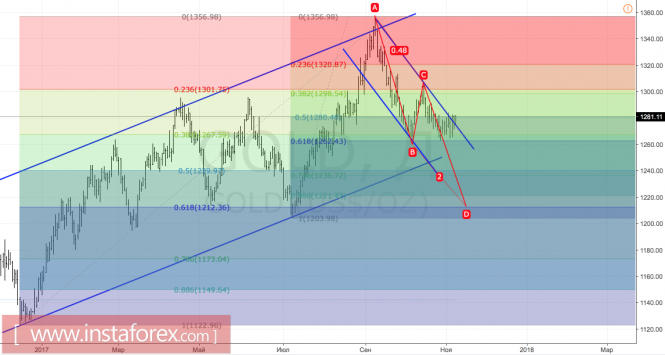The uncertainty surrounding the tax reform, the growth of geopolitical risks in the Middle East and the visit of Donald Trump to Asia allowed the bulls in gold to restrain their opponents who are on the offensive. There were rumors in the market that the start of the transformation of the fiscal system in the US could be postponed for a year due to the fact that the US economy is in good shape. If you add an incentive to this, it will increase the risks of overshooting inflation and a future recession. Given its current position, there is no certainty that the reform will be passed through the Congress: Democrats criticize the bill because of the losses of the middle class, while the number of dissatisfied Republicans is increasing. In general, the revision of the tax system is seen as a "bullish" factor for gold. Therefore, the problems with its implementation allows buyers of the XAU/USD to strike a counterattack.
Investors have raised their share of haven assets in portfolios, looking at events in the Middle East. The mass arrests in Saudi Arabia, the attack on Riyadh by rebels from Yemen, the conflict between Turkey and Kurdistan, and the dissatisfaction of Donald Trump with decisions of his predecessors on Iran's nuclear program have pushed up oil and bond prices. The yield of the latter is under pressure, which, due to the existing correlation, has a positive effect on precious metals.
Dynamics of gold and yield of US bonds

Source: Trading Economics.
An additional factor in supporting gold is U.S. President Donald Trump's tour in Asia. In Japan, Trump has already tickled the nerves of local businessmen, accusing them of non-commercial and non-mutually beneficial trade. In China, the US president raised the issue of ending its economic ties between Beijing and Pyongyang, which certainly provoked North Korea's discontent. Let me remind you that one of the most important drivers of almost 12% of the XAU/USD rally since the beginning of the year have been geopolitical tensions on the Korean peninsula and the US protectionist policy.
At the same time, from the point of view of macroeconomics, the precious metal's situation is not the best. While the euro area and Japan's GDP are growing above the trend, the US economy has been expanding by 3% or more for two consecutive quarters, and is also prepared to increase the rate. In the case of tax reform, investors prefer risky assets. Moreover, global inflation is characterized by sluggish growth. In this scenario, real world market rates have the prerequisites for a movement upwards, which should be considered as a "bearish" factor for XAU/USD.
In my opinion, the situation in the Middle East will soon stabilize, and the absence of conflicts with North Korea and the passage of tax reform through the Congress would raise the demand for the US dollar and return the quotes of precious metals futures for a downward short-term trend.
A technically successful test of the upper limit of the consolidation range at $1262-1281 per ounce will increase the risks of rising gold prices towards $1,299 and $1,320. On the other hand, a breakthrough of support at $1262 will allow the "bears" to count on the implementation of the targets for 161.8% and 200% for the AB=CD pattern.
Gold, daily chart
